Abstract
Object: In the article, the authors consider human capital as the driving force of the economy, identification of trends in relations, dynamics, prospects and results, where human capital influences the economic development of Kazakhstan. The aim of the study is to assess the critique of human capital development.
Methods: The results of the research are based on the fundamental theoretical and empirical work of leading Kazakh and foreign scientists devoted to the analysis of the processes of accumulation and use of human capital. General scientific principles and methods were applied: analysis and synthesis, system approach.
Findings: The basic components of basic human capital, such as education and training, Gross domestic product (GDP) growth, have been analysed. The authors analysed data from the UNESCO Institute for Statistics, Gross Enrolment Ratio (GER), which is an index illustrating the number of students enrolled at a given level of education. The results of the study showed that that health is the main component of human capital formation. T. Schultz suggested that health is a vital part of human capital formation, as it reflects living conditions. Life expectancy is the best indicator for determining health status.
Conclusions: The need for investment in research and development was noted since any investment in science and technology increases human capital in the country. Therefore, the next indicator to be considered is an investment in research and development in Kazakhstan. An analysis was made of the main criteria for the development of human capital in Kazakhstan, which revealed the strengths and weaknesses of the current situation in the country. An assessment of the different levels of education shows that the gross enrolment ratio in primary and secondary schools is quite high. However, the GER for higher education is quite low compared to other developed countries.
Human history has witnessed many different approaches to economic development, and one of the most interesting is research on human capital. Currently, there are many articles and scientific studies related to the impact of human capital on economic development, where it has been proven that human capital is directly related to the country's economy and its potential for growth.
The aim of the study is to assess the critique of human capital development. Identification of trends in relations, dynamics, prospects and results, where human capital influences the economic development of Kazakhstan.
Kazakhstan is one of the leading economies in Central Asia that has experienced tremendous economic growth since independence on 18 December 1991. Although Kazakhstan has maintained economic stability over the past two decades, recent national and foreign economic reports demonstrate that the Kazakh economy is stagnating.
To make an analysis of human capital in the Republic of Kazakhstan and its effect on economic growth, it is necessary to make the statistical overview. Thus, the estimation of effect requires a description of economic activity in the Republic of Kazakhstan. Without a general economic review of human capital components, it would be difficult to judge the impact. The analysis will start from basic components of human capital like education and training, and then will end by comparison of found statistics with GDP growth.
On the base of the statistical information, education can be presented as the factor of human capital accumulation in different forms. For instance, R. Barro used educational attainment as an element through which the influence of human capital on economic development was explained (Barro R., 1992). It is required to say that educational attainment can be separated into four groups. The first group includes people who did not participate in any school. The second one is applied to inhabitants who finished elementary school. The third and fourth group of population include people who graduated from secondary and higher education. It means that educational attainment can be implemented as a factor affecting economic growth. Therefore, it is important to outline the historical changes in educational attainment in the Republic of Kazakhstan.
The term «human capital» became known as an economic definition only in the second half of the 20th century. Economists such as Theodore Schultz and Gary Becker have based a new view on the importance of human capital in human development. These scientists have published a number of remarkable works that have profoundly changed the economic perspective on human resources. It is traditionally known that the first theoretical basis of human capital was written by T. Schultz, although the term «human capital» was used a hundred years ago. The influence that inspired T. Schultz to create the theory of human capital was done by Edward F. Denison in his study, where E.F. Denison mentioned that technological innovation and the industrial revolution contributed only half of the growth of Gross National Product (GNP), while other factors were improved management of production, labour intensity, etc. T. Schultz stressed the importance of education. He stated that investment in education ultimately turned into a level of quality in the labour force, as well as technological progress that led to improvements and productivity gains. Gary Becker is known for his outstanding contribution to human capital theory. Becker's theoretical studies were a breakthrough; his economic models became fundamental to traditional economics. Mr. Becker responds to why investing in human capital increases the productivity of people's labour.
The study used statistical data from the Ministry of Education and Science, data from the UNESCO Institute for Statistics, as well as scientific articles: Gennady N. Gamarnik., A. Baktymbet., A. Baktymbet., S. Baktymbet «Human capital education in the context a paradigm shift in education» by G.N. Gamarnik, A. Baktymbet, A.S. Baktymbet, «Economic and environmental aspects of the development of renewable energy in Kazakhstan» by Ukubassova, G.S. Baktymbet, A.M. Bakyrbekova /Journal of Environmental Management and Tourism. — Publisher: ASERS Publishing (Germany), A.S. Baktymbet, S.S. Baktymbet Socioeconomic aspects of the development of the educational system of Kazakhstan Gazette of ENU after M.L. Gumilev, Nur-Sultan.
Before looking at the statistics, it is essential to explain the meaning of gross enrollment ratio. According to UNESCO Institute of Statistics, gross enrollment ratio (GER) is index illustrating the number of understudies enlisted in a given level of instruction, notwithstanding of age, communicated as a rate of the official school-age populace comparing to the same level of instruction. The GER can be over 100 % because it incorporates understudies who may be more seasoned or more youthful than the official age bunch (UNESCO Institute for Statistics, 2020). The GER incorporates understudies who are rehashing a review, those who selected late and are more seasoned than their classmates, or those who have progressed rapidly and are more youthful than their classmates. This permits the overall enrolment to surpass the populace that compares to that level of instruction.
The first activity is schooling and higher education. It had previously been reconsidered that T. Schultz had a clear vision of education, and he believed that investment in education had a positive impact on earnings. This means that educated people are more competitive in the labour market than uneducated people. Thus, T. Schulz was concerned about the view that schooling was considered only as a cost of consumption (Schultz, T., 1961).
School and higher education are important parts of some specialities. Mr. Becker proposed an equation to explain the net earnings of students during school time (Becker, G., 1962). Before defining the equation, any economic entity that maximizes its income can only achieve equilibrium if its limit product is equal to its wage. Based on this assumption, the net income of students is defined as:
As can be seen in Figure 1, two lines are given, where the line «UU» determines the earnings of an untrained employee, and the line «TT» determines the trained employee. At first, it can be seen that an untrained worker has a higher salary than a trained worker. However, as a trained worker grows older, his or
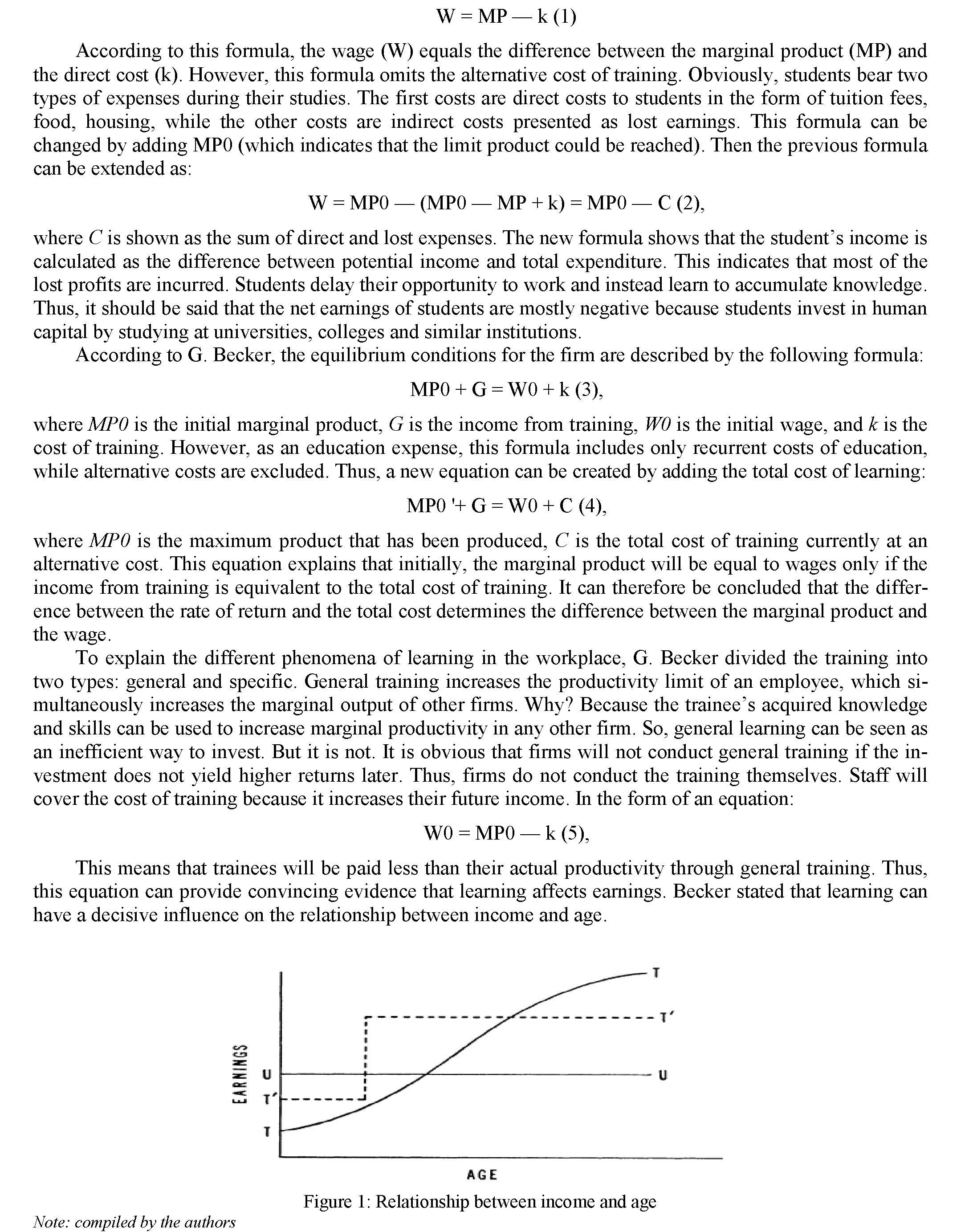
her wages increase faster, while the wages of an untrained worker remain unchanged. This indicates that the trained worker covers the cost of general training at a lower salary than his or her productivity.
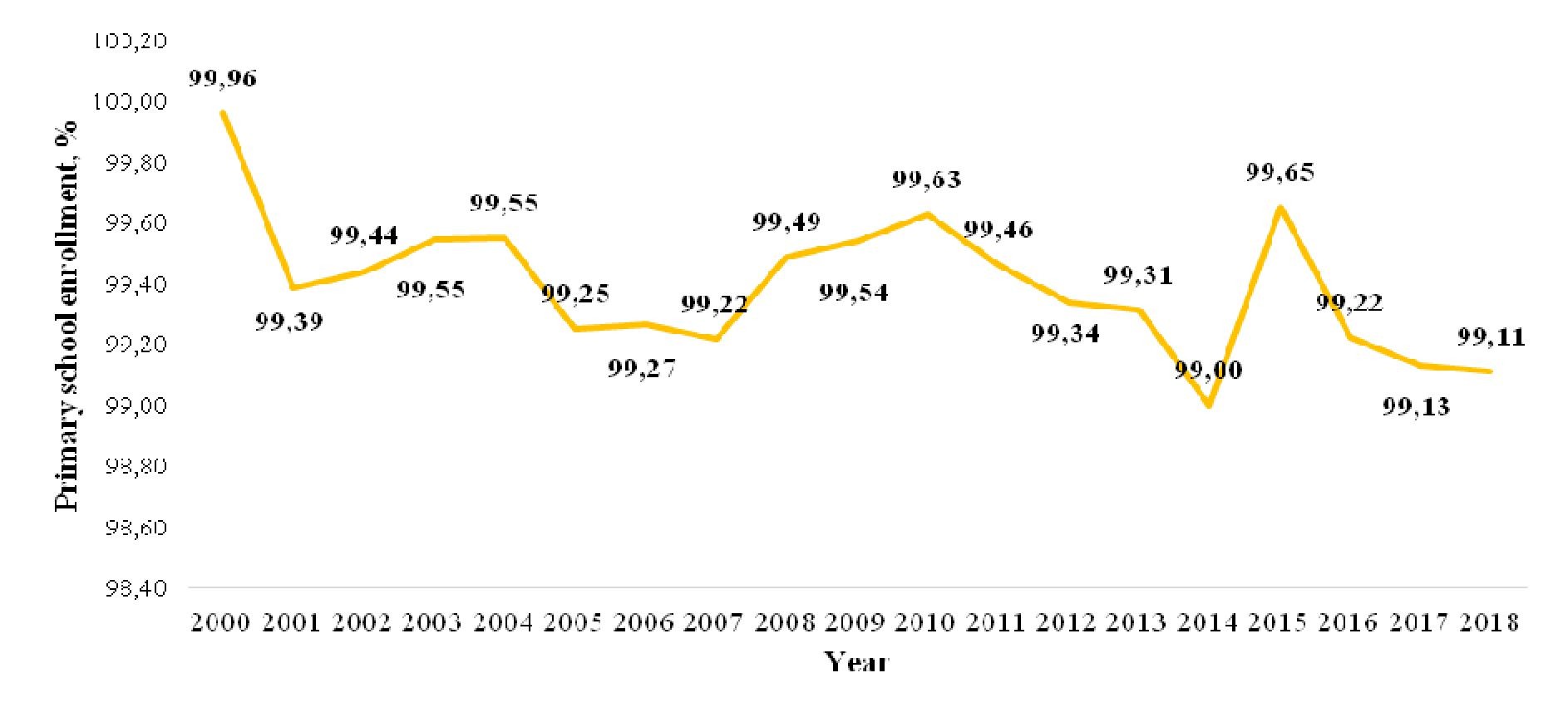
Figure 2: Primary school enrollment between 2000 and 2018
Note: compiled by the authors
According to statistics, on the Figure 2 has shown that about 99 % of students in the age group of 7–10 years participated in primary school from 2000 to 2018. It shows that in Kazakhstan almost all children in the age group of 7–10 years have studied in primary school. During 18 years, the participation rate does not change dramatically, which illustrates that the government provides all the conditions for children to have access to primary education. The high rate of participation in primary education definitely has a positive effect on literacy rate in Kazakhstan.
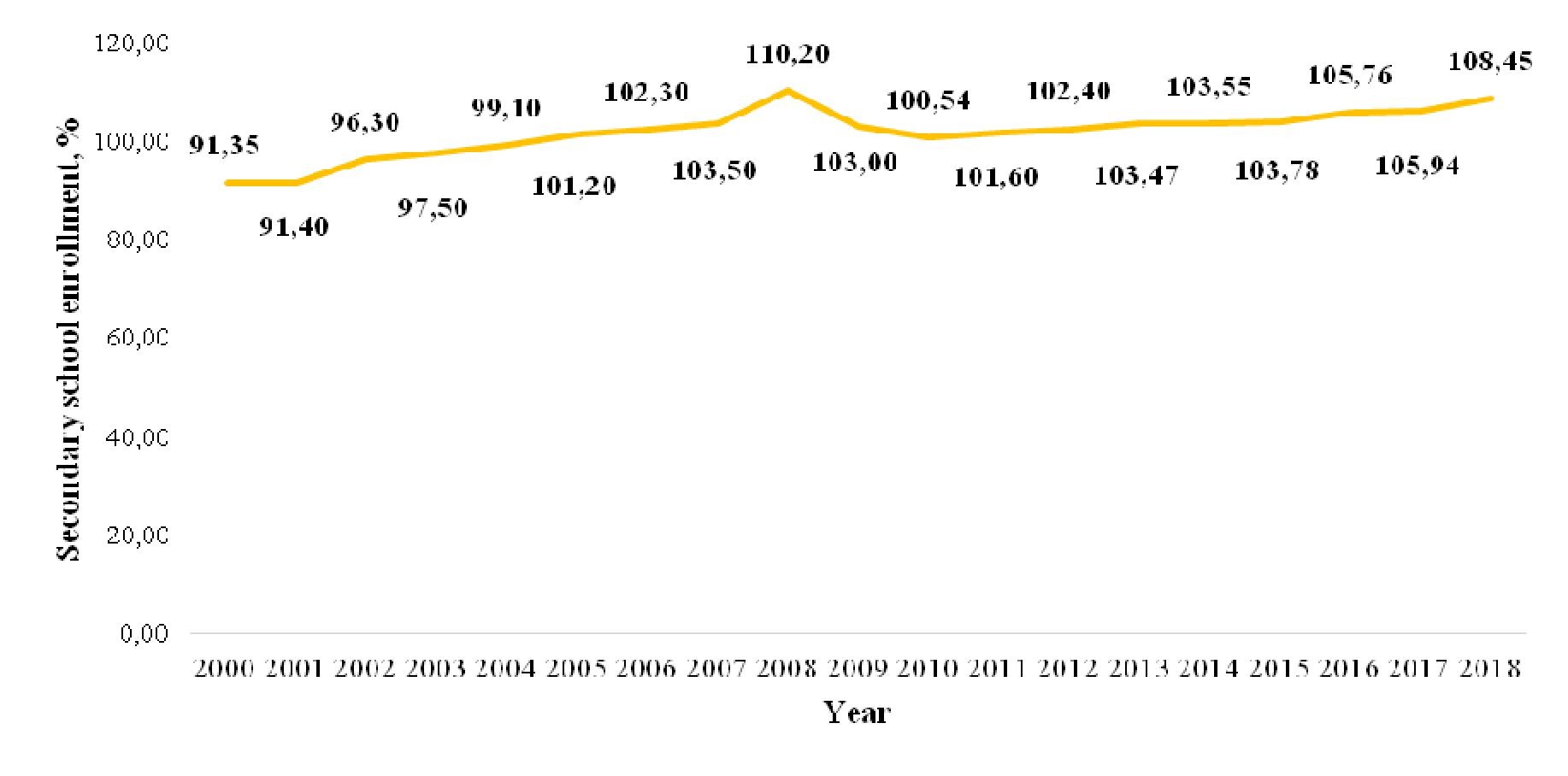
Figure 3: Secondary school enrollment between 2000 and 2018
Note: compiled by the authors
On the Figure 3 presented the secondary school enrollment between 2000 and 2018. Next data is related to a portion of the population who acquired secondary education. The highest index of gained secondary education can be noted in 2008 with a participation rate of 110,2 %. The lowest index might be found in 2000 with 91.35 per cent. The secondary school enrollment has a rising slope, where the number of participants in secondary education increases since 2000 and the average gross enrollment ratio of secondary educationequals to 108 per cent. It displays that the whole Kazakhstan's population gained secondary education and the index over 100 per cent explains that people from different age groups also ended secondary education together with students in age groups of 11–17 years.
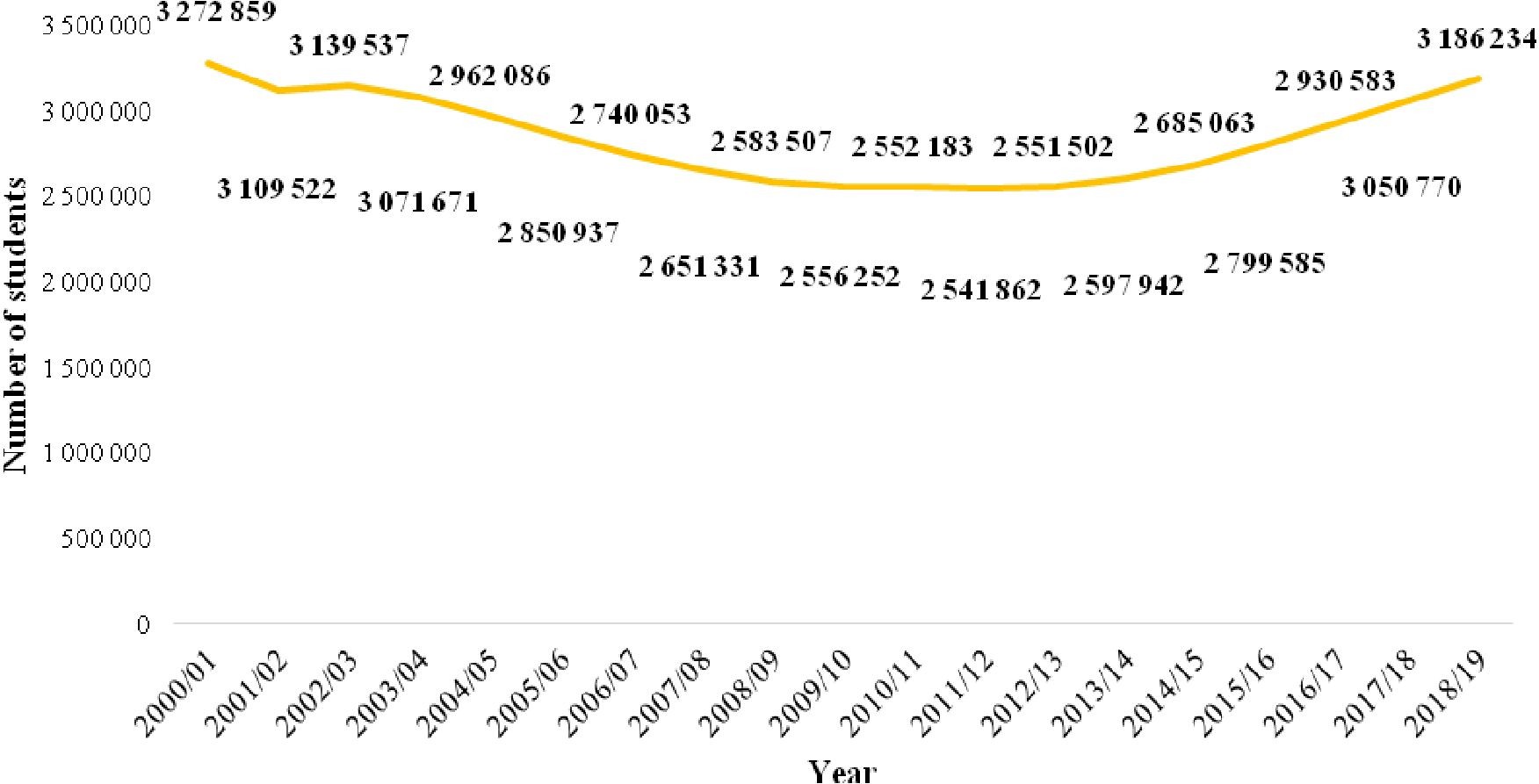
Figure 4: Number of students in secondary schools from 2000 to 2019
Note: compiled by the authors
As can be seen in Figure 4, according to the Ministry of Education and Science of the Republic of Kazakhstan, the number of students participating in secondary education has been changing every year. Notably, it is seen by the difference of understudies in 2000/01, 2009/10 and 2018/19. In 2000/01 the number of students was 3.2 million, whereas in 2009/10 the number of students dropped by 700 thousand and in 2018/19 the number of students increased back to 3.2 million. It shows that fertility rate can also be a factor affecting the enrollment in secondary education. However, the statistics illustrate that changes in the number of students over years did not affect enrollment in secondary education since it was only increasing. This example proves the assumption that only qualitative changes for students increased enrollment rate in secondary education.
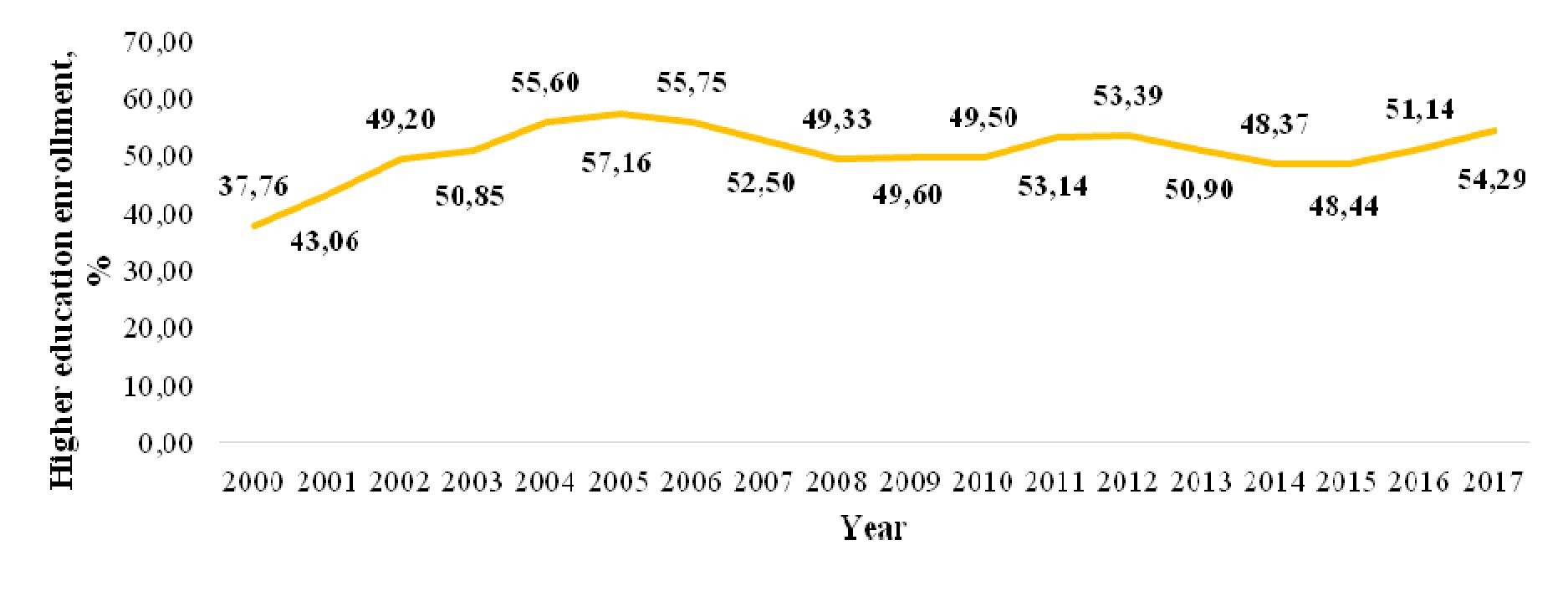
Figure 5: Higher education enrollment between 2000 and 2017
Note: compiled by the authors
On the Figure 5, we can see the higher education enrollment 2000 and 2017. The statistics show that number of students gained higher education was increasing since 2000. If in 2000 the participation rate in higher education was about 38 %, in 2008 the enrollment increased by 13 %. In 2017, higher education en-
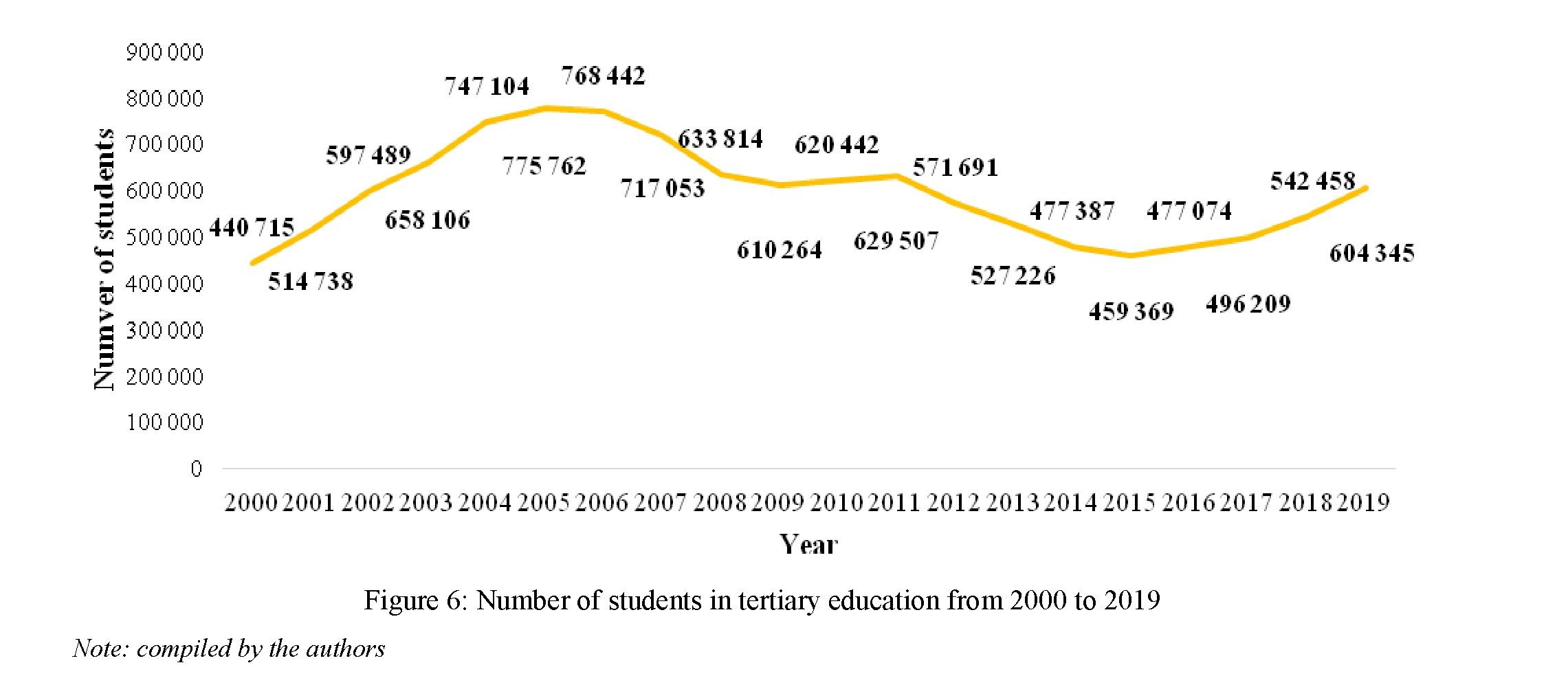
9
rollment constituted 55 %. These statistics indicate that people who are interested in gaining higher education was increasing over the years. Next indicator is tertiary education. The growing number of students in tertiary education shows that nation aims to increase its knowledge and professional experience meaning higher human capital accumulation within the nation and the growth of potential among students.
According to Figure 6, the number of students studying in tertiary education is more than a half-million people averagely. The biggest number of students was in 2006 with 768 thousand applicants, while the lowest was in 2000 with 440 thousand applicants. The trend shows that the number of students is slightly increasing over years. For example, the number of students in 2019 is almost the same as in 2009 (Statistics Committee of Ministry of National Economy of the Republic of Kazakhstan, 2020).
The level of skills of specialists is today one of the most important factors determining the level of development of a country’s economy (Baktymbet A.S, Ukubassova G.S., Baktymbet S.S., Baktymbet Assem, Bakirbekova A.M., 2020). The analysis suggests that the Republic has quite a strong human resource potential. The development of human capital in Kazakhstan is considered a prerequisite for the breakthrough development of Kazakh society, the acquisition of competitive advantages and the achievement of the country’s international competitiveness.
Many higher education institutions are not directly responsible for the employment of their graduates, especially those with a fee. The employment situation for university graduates is not satisfactory. There continues to be a high number of unemployed young professionals, as well as a high number of those who are not finding jobs in the chosen field. The existing duplication in the training of personnel in State and nonState higher education institutions leads to overproduction and different levels of training of specialists in the same field, making it difficult for the national-regional component to be taken into account in the educational standard, exacerbates the problem of job placement for graduates.
The decrease in the number of students from 2011 can be explained as an increase of new opportunities for Kazakhstan's students to receive scholarships in CIS countries, Europe and the US. Many of Kazakhstan's students are choosing to study abroad in order to get more qualitative and affordable knowledge. However, the recent growth in the number of students also illustrates that more and more young people are interested in getting higher education in Kazakhstan. Additionally, the role of government aid cannot be expelled. In 2018–2019 academic year, the Ministry of Education and Science of the Republic of Kazakhstan provided 53 thousand governmental scholarships for potential students.
However, it is not enough to view education from population side. Usually, the government is interested in funding educational institution to create a more skilled workforce.
On the Figure 7 has shown the investment in education between 2003 and 2018. The growth of investment size in education was varied from years to years. For instance, in 2003 investment size in education constituted 30 billion tenge, while in 2011 it increases to 130 billion tenge. The highest index of investment in education was reached in 2017 with 257.2 billion tenge, while the lowest index was revealed in 2003 with 30 billion tenge. The biggest growth of investment was in 2014 with 42.6 % and lowest growth in 2018 with -20.2 %.
According to the statistics, the trend of investment in education was gradually increasing from 2003. In 2009 and 2010, it can be noticed that investment in education slightly decreased and in 2011 it lightly increased. Generally, the index of investment in education shows that the government attempted to enlarge spending on education. However, the growth of spending on education is related to the growth of inflation rate and devaluation of tenge last years.
Data of investment in education shows that the government of Kazakhstan does not provide enough funds into education, since it accounts for 1.8 % of the total fixed capital investment (Gamarnik G., Baktymbet A., Baktymbet A., Baktymbet S., 2019). The level of investment in education of Kazakhstan is low comparing to the countries with the high human capital index as Norway or Denmark. For instance, in 2016 Norway's expenditure on education was 8 % of total GDP. Even the index of government expenditure in the world averagely constituted 4.5 % of total GDP. It means that Kazakhstan is paying less attention to supporting educational enhancement, even though the development of education is set as one of the priority objectives in the national strategy.
Moreover, it is significant to review investment in reseach and development (R&D) as well. As it was written in the theoretical part, any investment in science and technology enhances human capital within the nation (Baktymbet A.S, Baktymbet A., Baktymbet S.S., Yelshibayev R.K., Ukubassova G.S., 2020). Therefore, the next indicator to be reviewed is an investment in R&D in Kazakhstan.
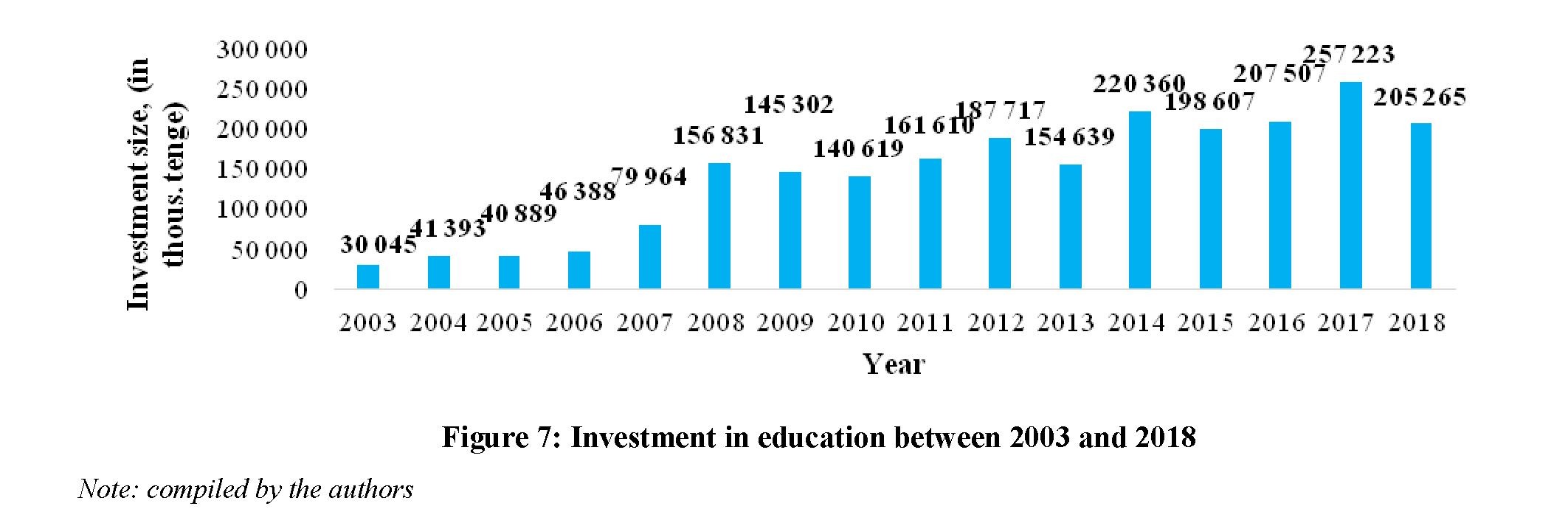
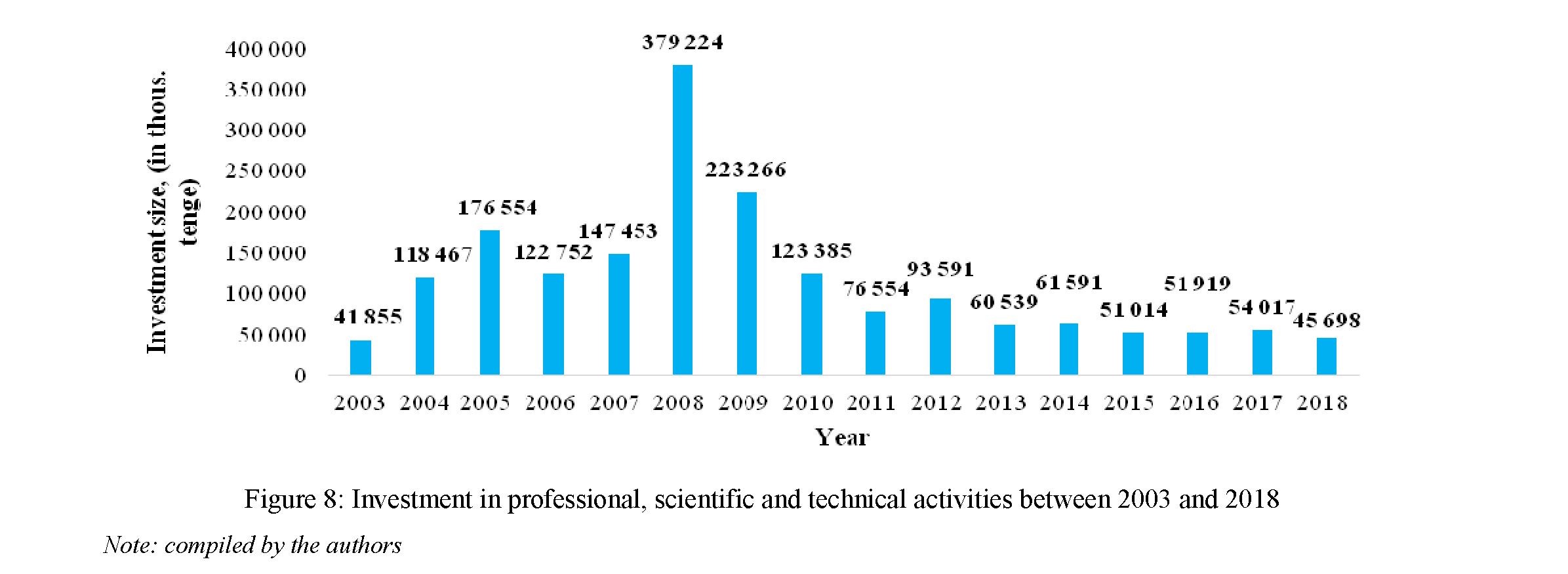

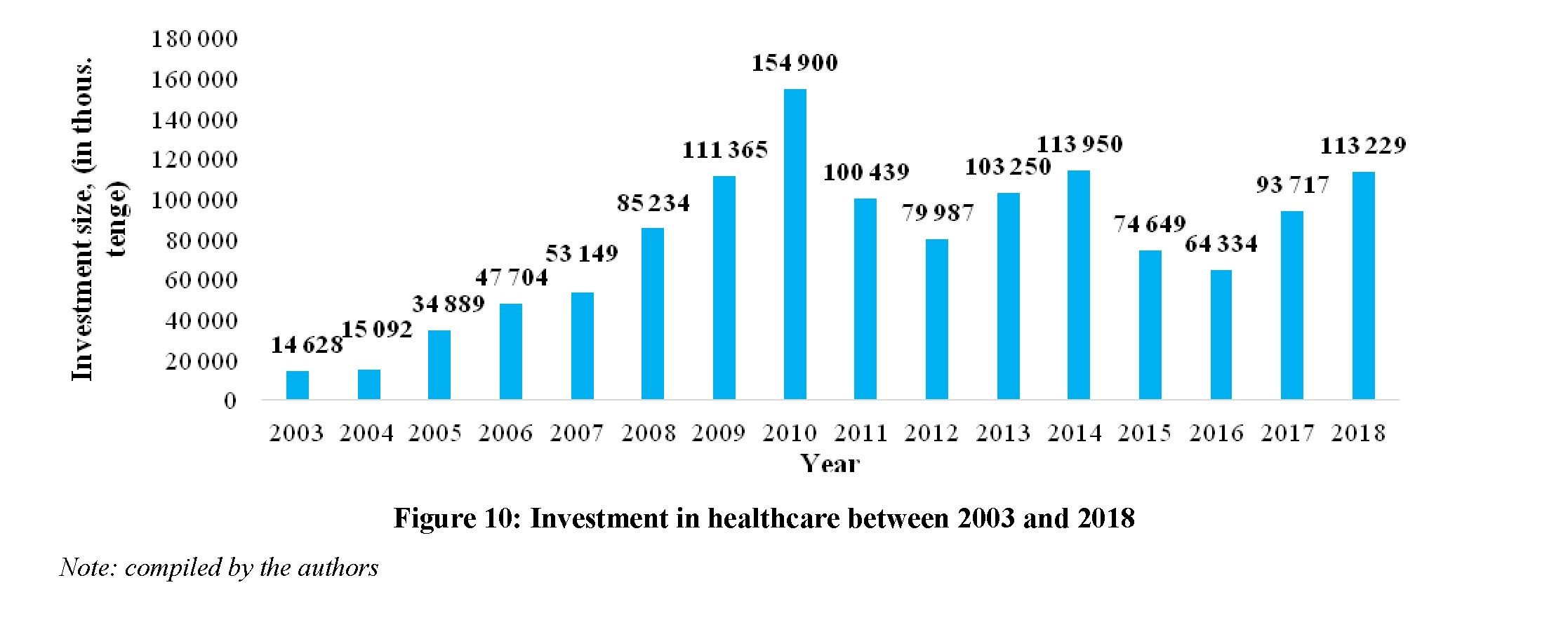
As it has presented in Figure 8, R&D investments were higher than investment in education in the same years. For example, in 2008 investment in professional, scientific and technical activities constituted about 380 billion tenge while investment in education in the same year was 156 billion tenge. It shows that a certain period of time Kazakhstan invested in R&D more than in education. However, the tendency illustrates that after 2008 (economic crisis) investment in R&D started to decrease and in 2018 investment was only 45 billion tenge (in comparison to 2017 the growth of investment on R&D decreased to 20 %). Low investment size in R&D might negatively affect the development of new technologies and decrease the scientific potential of the nation.
Next component of human capital formation is health. T. Schultz assumed that health is a vital part of human capital formation because it reflects life conditions. The best indicator for an indication of health status is life expectancy. Life expectancy is an average estimation of years that people can live based on factors as heredity, nutrition, etc.
On the Figure 9, we can see the life expectancy between 2000 and 2019. According to the provided data, life expectancy in Kazakhstan in 2000 was about 66 years for both genders. In the next 10 years, life expectancy increased for 3 years and at the end of 2019, the index of life expectancy reached 73.2 years for both genders. In general, from 2000 life expectancy was gradually increasing and up to 2019, the index grew for 8 years. Overall, the figure for life expectancy shows that living conditions in Kazakhstan have been increasing over years.
On the Figure 10 has shown the investment in healthcare between 2003 and 2018. The data of investment in healthcare illustrates that from 2003 to 2010 the investment size was steadily growing, while from 2011 to 2018 the investment in healthcare was fluctuating among 100 billion tenge. The highest investment in healthcare was detected in 2010 with 154 billion tenge a year, while the lowest was indicated in 2003 with only 14 billion tenge a year. Moreover, the data of investment in health reveals the tendency of increasing financial support of healthcare system since the budget of 2018 grew for 115.1 % in comparison to the previous year. However, in 2018 budget in healthcare constituted only 1 % of total fixed capital investment. Investment in healthcare is one of the core priorities in the theory of human capital and small budget regarded for the healthcare system in Kazakhstan illustrates one of the weakest parts that need improvement and governmental attention (Baktymbet A.S, Gamarnik G.N., Baktymbet S.S., Baktymbet A.S., 2019).
To sum up, the analysis of the main criteria of human capital development in Kazakhstan showed up the strengths and weaknesses of the current situation in the country. As it was given in the tables of different levels of educational attainment, indexes of gross enrollment ratio for primary and secondary education are reasonably high. However, the index of GER for tertiary education is quite low comparing to other developed countries. Therefore, it can be said that Kazakhstan needs serious improvement in tertiary education in means of quality and funding. Furthermore, the review of investment on education, R&D and health was made. According to the data of the Statistics Committee of Ministry of National Economy of the Republic of Kazakhstan, investment in education, R&D, and health is comparatively low and do not match standards of developed nations. It denotes that Kazakhstan should pay more attention to social projects and increase funding of education, R&D and health because these economic activities are vital for human capital development in the nation.
The Ministry of Labour and Social Protection is currently working on the preparation of professional standards that will contribute to the improvement of the system of vocational and higher education and the existing system for awarding qualifications.
Nevertheless, the development of the educational environment is gradually changing school curricula and educational technologies, «involving» teaching resources and educational technologies in the educational process. While the network of the educational organization is constantly growing, both within the system of general education and through the creation of joint educational programmes and projects with complimentary children’s organizations, cultural, physical and sports organizations and others. In developed countries, some 25–30 % of the education programme is already out of school. At the same time, university pools are creating new educational resource platforms and open online courses (MOOCS) to reduce costs while attracting new students to their institutions. Much of the individualization of education has been achieved through new learning technologies that allow for greater emphasis on the student’s work. At the same time, the increasing accessibility of higher education leads to an increase in its differentiation according to the quality of teaching (Baktymbet A.S., Baktymbet S.S., Baktymbet A.S., 2020).
The development and quality of the educational environment, which extends well beyond the education system itself (educational programmes of museums, educational tourism, an increasingly complex information environment), will play an increasingly important role in improving the quality of education and the accessibility and diversity of non-formal education. In fact, globally distributed universities with between 200 and 500 thousand students will be established. At the same time, unique programmes focusing on the individual needs of learners will be developed and built on global educational resources. The main requirement should be the feasibility of educational policy measures and the reduction of the risks of negative consequences. In this connection, policy measures should be aimed at creating modern educational conditions throughout the territory of the Republic of Kazakhstan and developing human capital.
References
- Barro R. (1992). Human Capital and Economic Growth. In: Policies for Long-Run Economic Growth. Federal Reserve Bank of Kansas City
- Baktymbet A.S, Ukubassova G.S., Baktymbet S.S., Baktymbet A., Bakirbekova A.M. (2020). Economic and environmental aspects of the development of renewable energy in Kazakhstan. Journal of Environmental Management and Tourism, 11 (5), 1025–1039.
- Baktymbet A.S, Baktymbet A., Baktymbet S.S., Yelshibayev R.K., Ukubassova G.S. (2020). The fourth energy transition and development of energy sector in Kazakhstan. Journal of Advanced Research in Law and Economics, 3(49), 735–746.
- Baktymbet A.S, Gamarnik G.N., Baktymbet S.S., Baktymbet A.S. The role of Kazakhstan in the framework of the SHOC. Vestnik Kargu, 4, 29–37.
- Baktymbet, A.S., Baktymbet, S.S., & Baktymbet, A.S. (2020). Sotsialno-yekonomicheskie aspekty razvitiia sistemy obrazovaniia Kazakhstana [Socio-economic aspects of the development of the educational system of Kazakhstan]. Vestnik Yevraziiskogo natsionalnogo universiteta imeni L.N. Gumilyova — Gazette of ENU after M.L. Gumilev, 3, 26–36 [in Russian].
- Becker G. (1962). Investment in Human Capital: A Theoretical Analysis. Journal of Political Economy, 70(5), 9–49. Retrieved from http://www.jstor.org/stable/1829103
- Biuro natsionalnoi statistiki Agentstva po strategicheskomu planirovaniiu i reformam Respubliki Kazahstan [Bureau of National Statistics Strategic Planning Agencies planning and reforms of the Republic of Kazakhstan]. — 2021 [in Russian].
- Gamarnik G., Baktymbet Aisara, Baktymbet A., Baktymbet S. (2019). Human capital education in the context a paradigm shift in education. Central Asian Economic Review, 4, 25–37.
- Schultz T. (1961). Investment in Human Capital. The American Economic Review, 51(1), 1–17. Retrieved from http://www.jstor.org/stable/1818907
- UNESCO Institute for Statistics (n.d.). Gross enrolment ratio. UIS.UNESCO.org. Retrieved from April 29, 2020, from http://uis.unesco.org/en/glossary-term/gross-enrolment-ratio